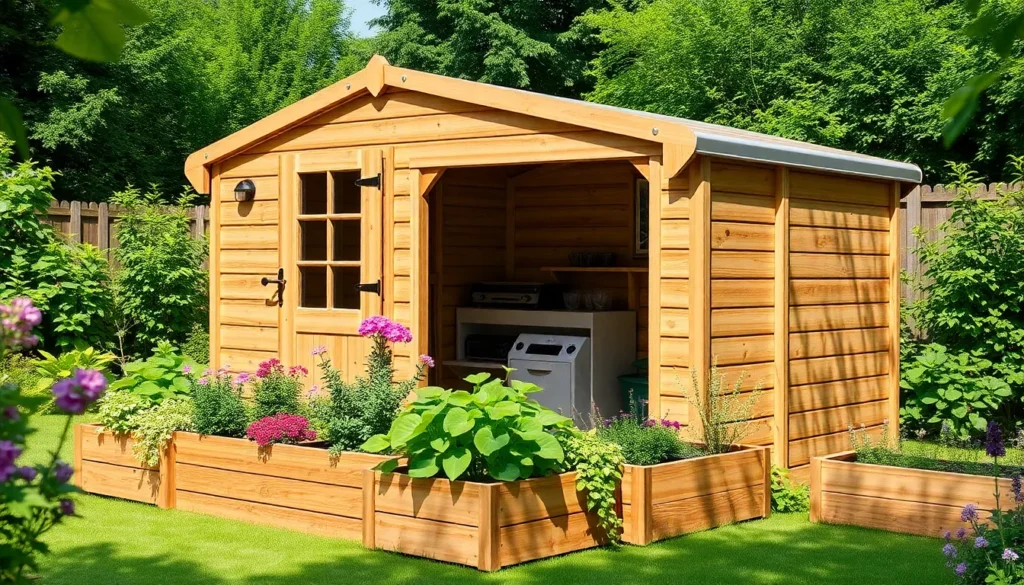Imagine waking up to the sound of birds chirping and the smell of fresh herbs wafting through your window. Self-sustainable living isn’t just a trend; it’s a lifestyle choice that lets you be the master of your domain—without a landlord breathing down your neck. Who wouldn’t want to grow their own food, harness the sun’s energy, and reduce their carbon footprint while looking like a modern-day eco-warrior?
In a world where convenience often trumps sustainability, embracing self-sufficiency can feel like a quirky adventure. Picture yourself trading grocery store runs for a backyard garden and swapping plastic bottles for homemade compost. Not only does this lifestyle save money, it also offers a sense of fulfillment that online shopping can’t compete with. Dive into the world of self-sustainable living and discover how a few simple changes can lead to a greener, happier life.
Table of Contents
ToggleUnderstanding Self Sustainable Living
Self-sustainable living focuses on creating an independent lifestyle that minimizes reliance on external systems. This lifestyle combines eco-friendly practices, efficient resource management, and a commitment to self-reliance.
Definition of Self Sustainable Living
Self-sustainable living refers to practices individuals adopt to meet their own needs without depleting natural resources. It encompasses growing food, harnessing renewable energy sources, and reusing materials. Individuals may cultivate local gardens or install solar panels to empower their homes. This approach significantly reduces environmental impact while promoting personal responsibility.
Importance of Self Sustainable Living
Self-sustainable living plays a critical role in reducing carbon footprints and conserving natural resources. Adopting these practices leads to less waste and diminished dependency on industrial systems. Additionally, it fosters community resilience and encourages the local economy. Individuals benefit from healthier lifestyles through fresh, organic produce while also gaining a sense of accomplishment. Ultimately, this lifestyle supports both individual growth and environmental stewardship.
Benefits of Self Sustainable Living
Self-sustainable living offers numerous benefits, contributing positively to both individuals and the environment. Engaging in sustainable practices fosters a healthier lifestyle, enhances economic stability, and supports global ecological efforts.
Environmental Impact
Environmental benefits play a crucial role in self-sustainable living. Reducing reliance on non-renewable resources lowers carbon footprints significantly. Individuals who grow their own food utilize fewer transportation resources, aiding in lower emissions. Utilizing renewable energy sources, like solar or wind, further decreases environmental degradation. Composting organic waste enriches soil while minimizing landfill contributions. Additionally, preserving local ecosystems protects biodiversity and promotes natural habitats.
Economic Advantages
Self-sustainable living also offers substantial economic advantages. By growing their own food, individuals can cut grocery bills significantly. Producing energy through solar panels decreases reliance on utility companies, resulting in lower energy bills. DIY projects foster creativity and skills, reducing costs associated with professional services. People who engage in barter systems for goods and services foster local economies, encouraging community cooperation. Overall, self-sustainability promotes financial independence while supporting sustainable community development.
Key Components of Self Sustainable Living
Self-sustainable living relies on several key components that empower individuals to thrive independently. These include energy generation, water management, and food production. Each element plays a crucial role in creating a self-sufficient lifestyle.
Energy Generation
Energy generation involves using renewable resources to power homes and devices. Solar panels provide a clean way to harness sunlight, while wind turbines capture wind energy. Geothermal energy offers an efficient heating solution, tapping into the Earth’s internal heat. Utilizing these technologies significantly reduces reliance on fossil fuels. Individuals often experience lower energy bills while contributing to environmental preservation.
Water Management
Water management focuses on conserving and efficiently using water resources. Rainwater harvesting systems collect water from roofs, storing it for gardens and household use. Greywater recycling repurposes water from sinks and showers, reducing overall consumption. Implementing drip irrigation systems ensures plants receive the right amount of moisture. These practices not only lower water bills but also promote responsible stewardship of a vital resource.
Food Production
Food production emphasizes growing one’s own food through various methods. Home gardens allow individuals to cultivate vegetables and herbs easily. Community gardens foster collaboration while providing access to fresh produce. Small-scale permaculture systems enrich soil health, increasing biodiversity. Each approach contributes to a sustainable food source, significantly lessening reliance on commercial agriculture. Tablets and garden plots improve nutrition and cooking creativity, enhancing overall well-being.
Challenges of Self Sustainable Living
Self-sustainable living presents various challenges that individuals must consider. Addressing these obstacles is crucial to achieving long-term self-sufficiency.
Initial Investment
Initial investments can be significant when establishing a self-sustainable lifestyle. Purchasing solar panels, building a greenhouse, or creating a rainwater harvesting system requires upfront capital. While these investments often pay off over time through reduced utility bills and self-sufficient food production, the high costs can deter some. Assessing local conditions also plays a role in guiding decisions about which systems to implement and their potential return on investment. Many individuals find financial assistance programs or grants beneficial when starting their journey toward self-sustainability.
Maintenance and Labor
Maintenance and labor demand considerable time and effort in self-sustainable living. Managing gardens, maintaining energy systems, and ensuring water conservation require consistent attention. Many individuals underestimate the physical labor necessary for upkeep, especially during peak seasons. Investing in proper tools and establishing maintenance routines can mitigate some of this labor intensity. Despite the challenges, many find the hands-on aspect rewarding, developing skills and fostering a connection with their environment. Rescue organizations or local community groups often provide support or share knowledge, alleviating some burden through collaboration.
Embracing self-sustainable living opens doors to a more fulfilling and environmentally friendly lifestyle. By taking small steps towards independence individuals not only enhance their quality of life but also contribute positively to the planet. The journey may involve challenges but the rewards of self-sufficiency and community engagement often outweigh the initial hurdles.
As more people adopt these practices the collective impact can lead to significant changes in local ecosystems and economies. Ultimately self-sustainability isn’t just a personal choice; it’s a movement towards a greener future that benefits everyone.










